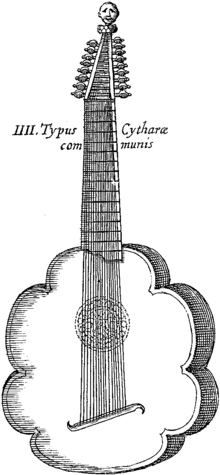- Orpharion
-
 An orpharion, labeled cythara communis, from Kircher's Musurgia Universalis
An orpharion, labeled cythara communis, from Kircher's Musurgia Universalis
The orpharion (pronounced /ˌɔrfəˈraɪən/ or /ɔrˈfæriən/) or opherion (/ɒˈfɪəriən/) is a plucked instrument from the Renaissance. It is part of the cittern family. Its construction is similar to the larger bandora. The metal strings are tuned like a lute and are plucked with the fingers. Therefore, the orpharion can be used instead of a lute. The nut and bridge of an orpharion are typically sloped, so that the string length increases from treble to bass. Due to the extremely low-tension metal strings, which would easily distort the notes when pushed down, the frets were almost flush with the fingerboard, which was gently scalloped. As with all metal-strung instruments of the era, a very light touch with the plucking hand was required, quite different from the sharper attack used on the lute.
The orpharion was invented in England in the second half of the 16th century. In sources of English music it is often mentioned as an alternative to the lute. According to Stow's "Annals" (1631), John Rose of Bridewell invented the instrument in 1581. There is a Rose Orpharion in Helmingham Hall which was allegedly given as a gift to Queen Elizabeth, and may well be that first example. It has 6 courses and the bridge and nut are parallel. The only other surviving Orpharion, now in the Claudius Collection in Copenhagen, has 9 courses with sloping frets, and dates to 1617.
The name of Orpharion comes from "Orpheus" and "Arion".
Categories:- Mandolin family instruments
- String instrument stubs
Wikimedia Foundation. 2010.
